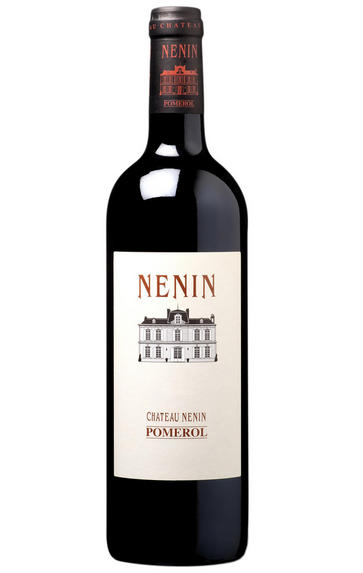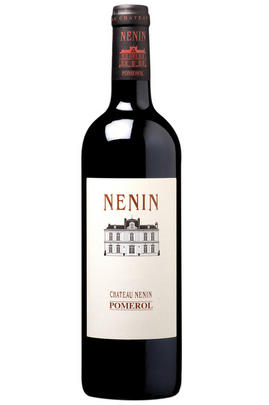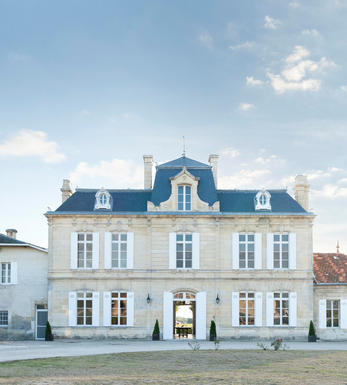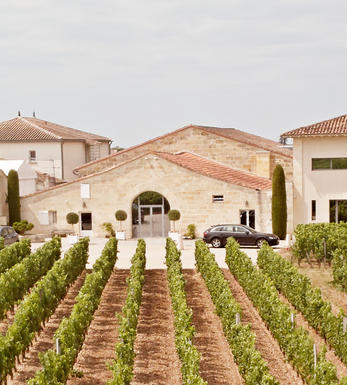
2014 Château Nenin, Pomerol, Bordeaux

Critics reviews
The 2014 Nenin has a simple, clean redcurrant and cranberry scented bouquet that feels a little anonymous, does not quite exude Pomerol. The palate is medium-bodied with sappy red fruit, nicely balanced with red cherry, cranberry and raspberry laced with black pepper and sage. The finish feels cohesive and persistent. This is a fine Pomerol that should offer 15 to 20 years of drinking pleasure. Tasted blind at the annual Southwold tasting.
Drink 2021 - 2036
Neal Martin, vinous.com (Mar 2018)
The 2014 Nenin was a bit of a whipcracker when I tasted it from barrel, so I was intrigued to find whether it would replicate that performance now in bottle. The bouquet is very well defined, perhaps more minerally and taut than previous vintages with truffle-tinged red berry fruit unfurling in the glass. There is also a potent tang of the sea (kelp or oyster shell perhaps). The palate is very well balanced, supple in the mouth, but it exerts a pleasant grip in the mouth and much more purity than vintages tasted over the 1990s and 2000s. This builds on that promise in barrel and is really quite a lovely Pomerol deserving of its newly designed label.
Drink 2020 - 2040
Neal Martin, Wine Advocate (Mar 2017)
81% Merlot, 19% Cabernet Franc. Mid garnet – still plenty of red in the colour. Very pretty nose of chalky dark-red fruit and something a little peppery/dusty. Melted, fine-boned tannins. I would fall on this in a restaurant for perfect current drinking though there's no hurry.
Drink 2019 - 2025
Julia Harding MW, jancisrobinson.com (Jun 2019)
About this WINE

Château Nénin
Château Nénin is a rather large property in the appellation of Pomerol on Bordeaux’s Right Bank. It’s located just outside the village of Catusseau. Jean-Hubert Delon, proprietor of Château Léoville Las Cases, long knew Château Nénin’s potential; he bought it from the Despujol family in 1997. The Delon family quickly got to work, with major investment and renovation in the vineyard and the winery – replanting a huge amount of the vineyard to best suit the soils here. Of the estate’s 32 hectares, around 25 are currently in production, planted to Merlot, Cabernet Franc and Cabernet Sauvignon. Unusually for Pomerol, most plantings are in one block, which is surrounded on two sides by Château Trotanoy. There’s also a smaller plot near Le Pin.
The Cabernet Franc here is the result of massal selection of Léoville Las Cases. The technical team here believe that this enhances the purity and elegance of the fruit. The use of new oak is relatively restrained, with experiments underway with alternative vessels including glass vats, large oak vessels and terracotta. The property benefits greatly from the Delon family’s Left Bank savoir-faire, but it remains true to its Pomerol roots. This is an ever-more precise and elegant Pomerol, with huge ageing potential and offering value for money.

Pomerol
Pomerol is the smallest of Bordeaux's major appellations, with about 150 producers and approximately 740 hectares of vineyards. It is home to many bijou domaines, many of which produce little more than 1,000 cases per annum.
Both the topography and architecture of the region is unremarkable, but the style of the wines is most individual. The finest vineyards are planted on a seam of rich clay which extends across the gently-elevated plateau of Pomerol, which runs from the north-eastern boundary of St Emilion. On the sides of the plateau, the soil becomes sandier and the wines lighter.
There is one satellite region to the immediate north, Lalande-de-Pomerol whose wines are stylistically very similar, if sometimes lacking the finesse of its neighbour. There has never been a classification of Pomerol wines.
Recommended Châteaux : Ch. Pétrus, Vieux Ch. Certan, Le Pin, Ch. L’Eglise-Clinet, Ch. La Conseillante, Ch. L’Evangile, Ch. Lafleur, Trotanoy, Ch. Nenin, Ch. Beauregard, Ch. Feytit-Clinet, Le Gay.

Merlot
The most widely planted grape in Bordeaux and a grape that has been on a relentless expansion drive throughout the world in the last decade. Merlot is adaptable to most soils and is relatively simple to cultivate. It is a vigorous naturally high yielding grape that requires savage pruning - over-cropped Merlot-based wines are dilute and bland. It is also vital to pick at optimum ripeness as Merlot can quickly lose its varietal characteristics if harvested overripe.
In St.Emilion and Pomerol it withstands the moist clay rich soils far better than Cabernet grapes, and at it best produces opulently rich, plummy clarets with succulent fruitcake-like nuances. Le Pin, Pétrus and Clinet are examples of hedonistically rich Merlot wines at their very best. It also plays a key supporting role in filling out the middle palate of the Cabernet-dominated wines of the Médoc and Graves.
Merlot is now grown in virtually all wine growing countries and is particularly successful in California, Chile and Northern Italy.


Buying options
Add to wishlist
Description
The 2014 Nenin has a simple, clean redcurrant and cranberry scented bouquet that feels a little anonymous, does not quite exude Pomerol. The palate is medium-bodied with sappy red fruit, nicely balanced with red cherry, cranberry and raspberry laced with black pepper and sage. The finish feels cohesive and persistent. This is a fine Pomerol that should offer 15 to 20 years of drinking pleasure. Tasted blind at the annual Southwold tasting.
Drink 2021 - 2036
Neal Martin, vinous.com (Mar 2018)
wine at a glance
Delivery and quality guarantee